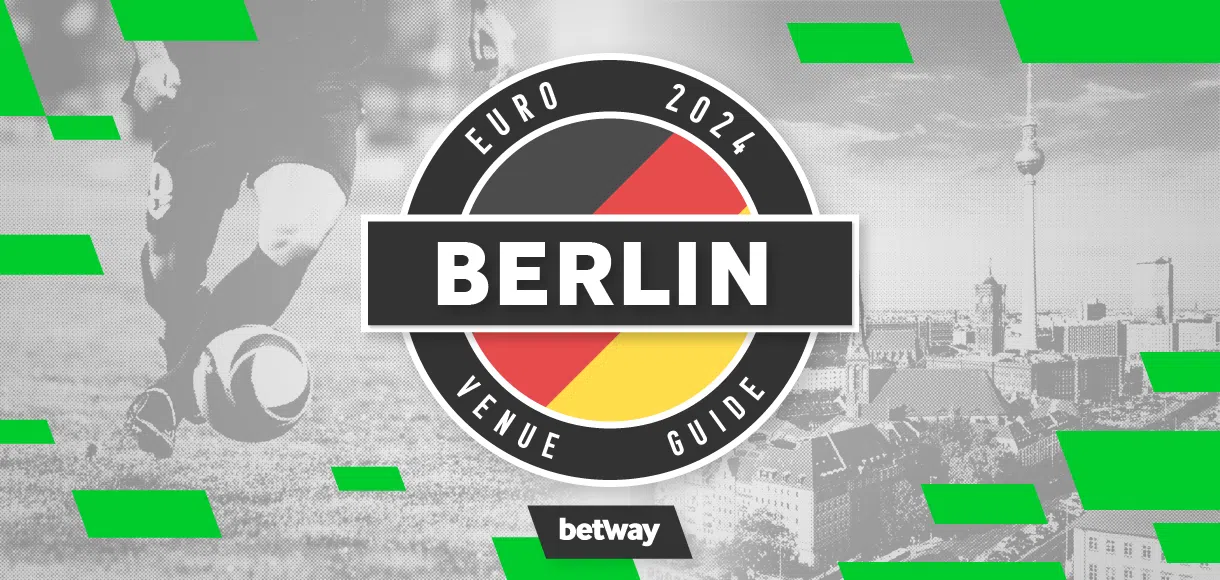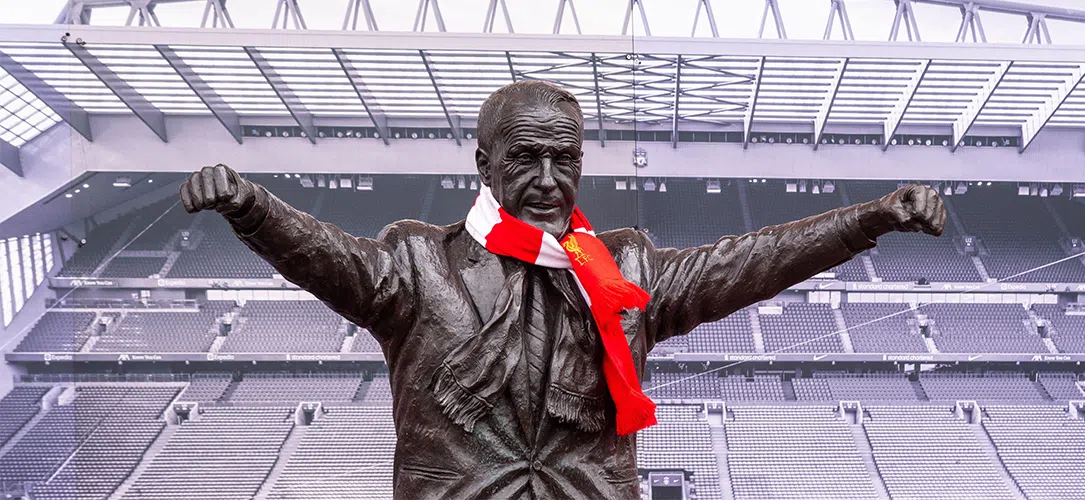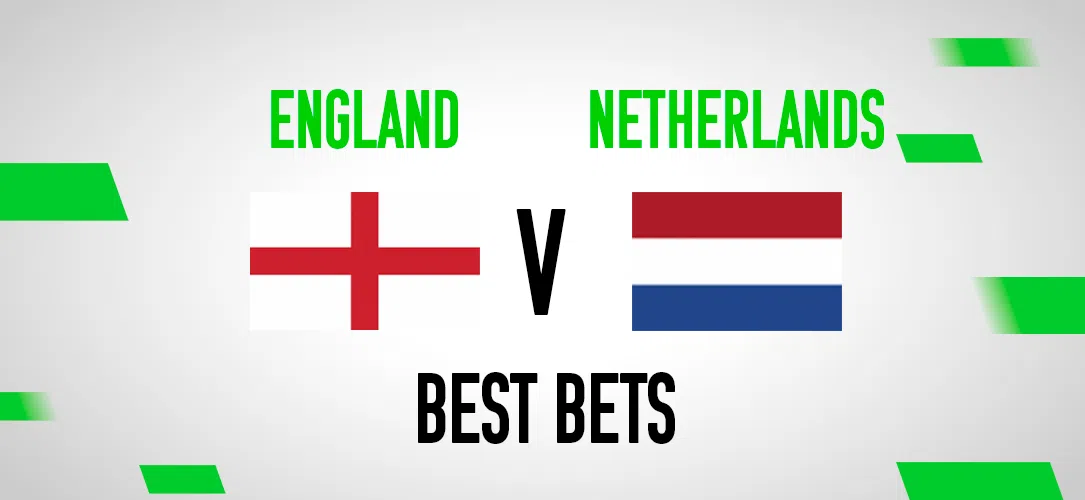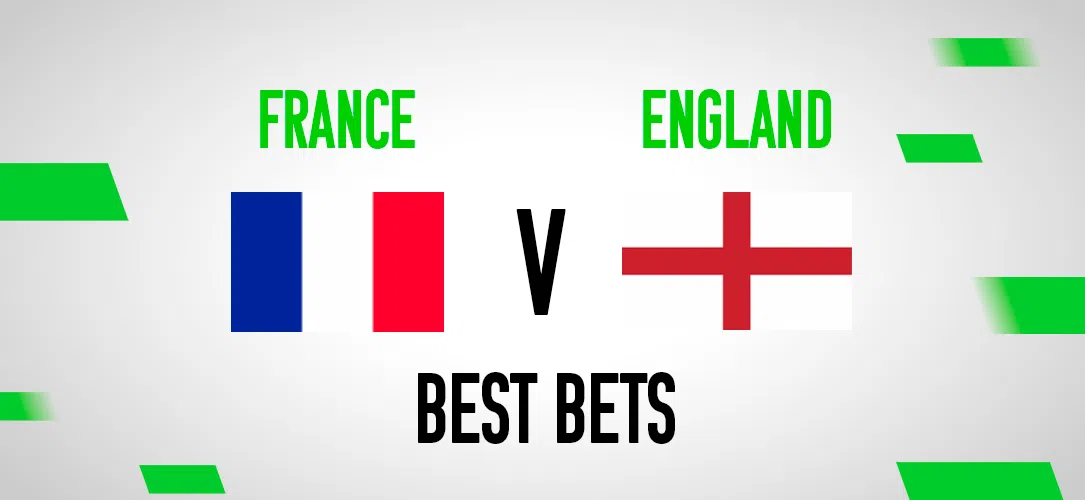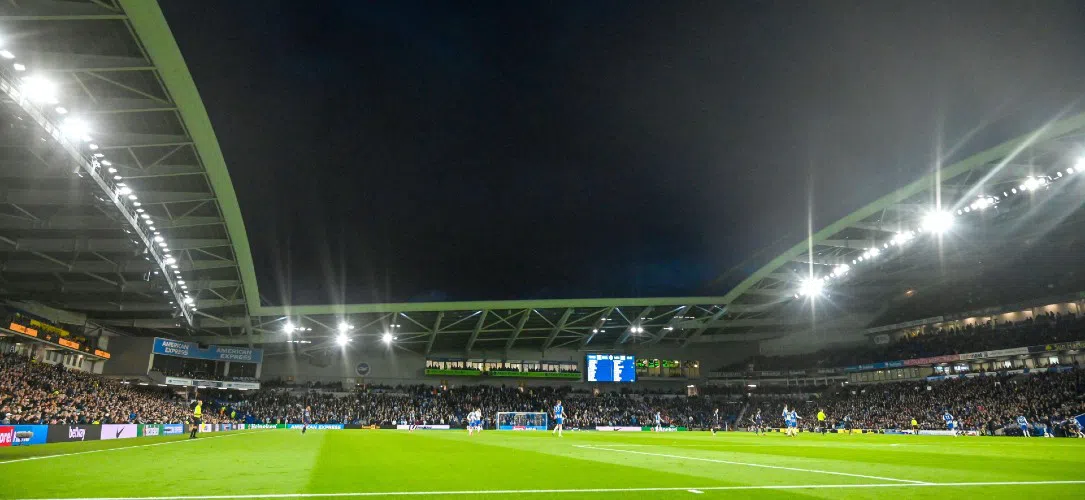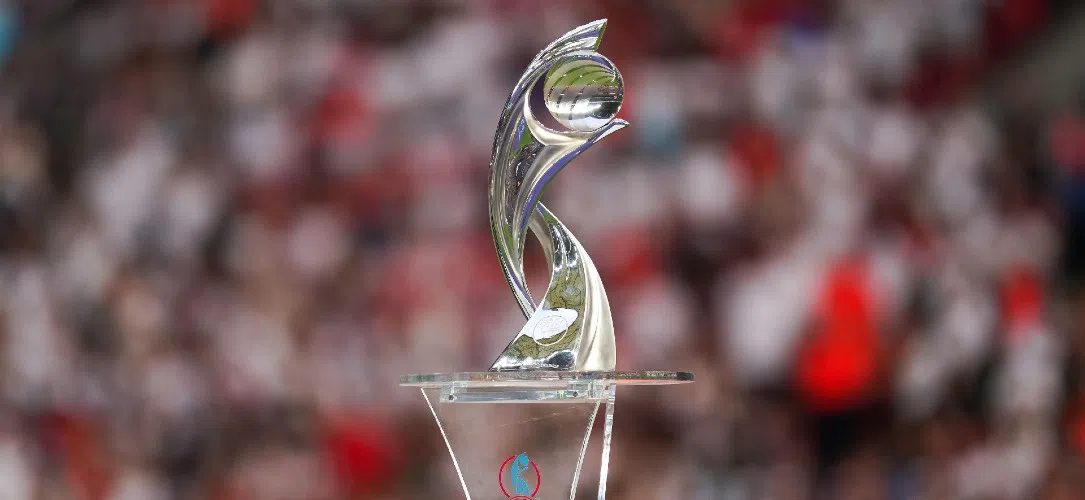Read our complete guide to visiting Berlin for Euro 2024 and discover all you need to know about making it a trip to remember. Find out more.
With the Euros just around the corner, Berlin is gearing up to help host the tournament and give football fans a summer to remember.
With the city well underway in its preparations, we’ve created the complete Berlin travel guide for Euro 2024, providing you with all the necessary information to make it a once-in-a-lifetime trip. Whether you’re visiting for one game or the whole tournament – or simply soaking up the atmosphere – read on to find out all you need to know and what to do in Berlin this summer.
In this Berlin travel guide:
· Which Euro 2024 matches are being held in Berlin?
· Visiting Berlin’s Olympiastadion
· Where is the Euro 2024 fan zone in Berlin?
· How to get from Berlin airport to the city centre
· Where to stay in Berlin for Euro 2024
· How to travel around Berlin
· Where to eat in Berlin
· Berlin’s most picturesque photo spots
· The best day trips from Berlin
· Final things to know before visiting Berlin for the Euros
· Explore the other Euro 2024 host cities
Which Euro 2024 matches are being held in Berlin?
Berlin is set to host six matches during Euro 2024, from group stage action to knockout drama – including the tournament’s expectedly-epic finale on July 14th.
With European powerhouses such as Austria, Croatia, the Netherlands, and Spain stepping out to impress this summer, the city’s iconic Olympiastadion will quickly become a hive of excitement. One thing’s for sure; supporters visiting Berlin for the Euros are in for an unforgettable experience.
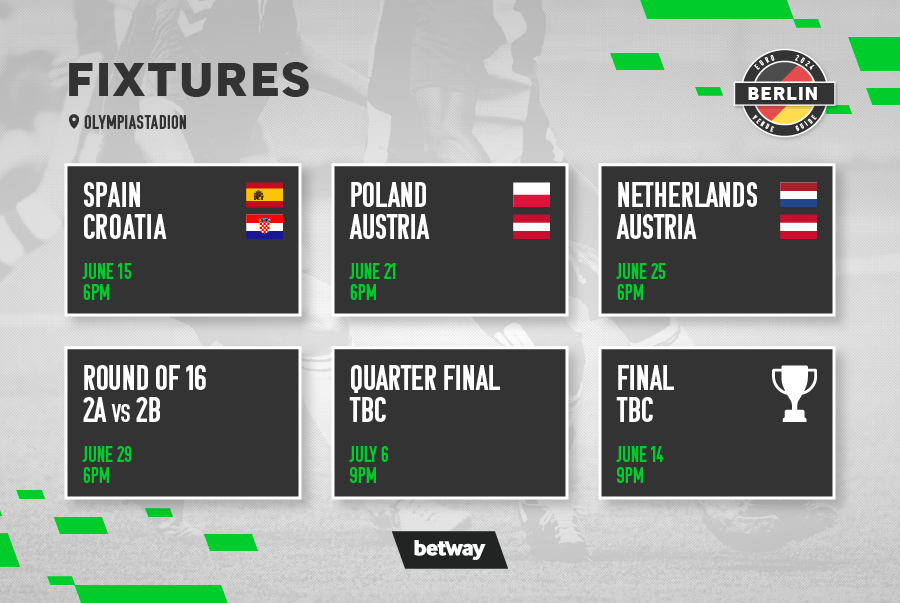
Visiting Berlin’s Olympiastadion
The centrepiece of Berlin’s Olympic Park, the Olympiastadion is located just outside the city centre, and is easily accessible by public transport.
How to get to the Olympiastadion
Likely near the top of your list of things to do in Berlin, especially if you’re visiting for Euro 2024, the Olympiastadion is conveniently accessible via public transport, with regular buses and trains from the city centre.
· S-Bahn: Catch an S-Bahn on the S9 line to Olympiastadion Station. Direct travel from Berlin is available from various major stations, including Hauptbahnhof, Alexanderplatz, and Ostkreuz.
· U-Bahn: Catch a U-Bahn on the U2 line to Olympiastadion Station. Direct travel from Berlin is available from various major stations, including Zoologischer Garten and Alexanderplatz.
· Bus: Catch a bus on either the M49 or 218 lines, from the city centre to Flatowallee. Alternatively, go to Neu-Westend Station – where you can either catch a U-Bahn to Olympiastadion Station, or make the short walk to the venue.
When planning your route to the Olympiastadion, make sure to check the latest timetables – there are likely to be additional trains planned in for gamedays.
Where to park at the Olympiastadion
Situated outside the city centre, the Olympiastadion is accessible by car. However, official guidance for match-going fans visiting Berlin is to avoid driving to the stadium on gamedays, as the parking will typically be over-subscribed, and it can be difficult to find a spot.
If you do need to drive, consider parking away from the stadium and finishing your journey via public transport. However, if you’re visiting between games, there’s often plenty of free parking available around the Olympiastadion.
Olympiastadion history
Originally built to host the 1936 Olympics, the Olympiastadion has hosted its fair share of iconic events and sporting legends. Notably, it was the venue for the 2006 FIFA World Cup Final, where Italy’s penalty shootout victory was somewhat overshadowed by Zinedine Zindane’s moment of madness! Since, it’s also hosted a FIFA Women’s World Cup fixture and the 2015 Champions League Final – where Messi and co. helped Barcelona win a fifth title.
Outside of football, the Olympiastadion also witnessed Usain Bolt break the 100m and 200m world records during the 2009 World Championships – as well as Jesse Owens’ historic gold medal performances at the ’36 Games. Outside the stadium, you’ll notice one of the streets is actually named after the former US athlete!
Best Olympiastadion selfie spots
There are various iconic selfie spots around the Olympiastadion, with each showcasing the venue’s standout architecture and history. Some of the best Insta-worthy selfie locations in and around the stadium include:
· Olympic Rings: Visually striking and immediately identifiable, the Olympic Rings are suspended between two tall columns and are a classic Olympiastadion backdrop – sure to set the scene for a striking selfie. Originally erected for the 1936 Olympics, the rings represent the historic games, and act as a reminder of the city’s athletic and sporting heritage.
· Marathon Gate: Situated within the Olympiastadion, you might want to get to the game early to get a selfie directly in front of this stand-out scene! A landmark fixture, the Marathon Gate originally marked the finishing line during the 1936 Olympic marathon race.
· Bell Tower: Visiting the top of the Bell Tower gives you stunning views of the Olympiastadion and its surrounding area – perfect for panoramic selfies. The unique vantagepoint makes for instantly-sharable social media content!
Of course, you’re also guaranteed to get picture-perfect selfies in front of the stadium’s imposing exterior, as well as from your seat, with the impressive and distinctive interior offering a dynamic backdrop.
Refreshments at the Olympiastadion
On a typical matchday at the Olympiastadion, the Berlin venue offers 36 independent food stalls, which equates to a stand per 2068 attendees – assuming the stadium is at full capacity. This is the third-highest rate of stalls of all Euro 2024 arenas, so fans visiting Berlin are sure to be well-refreshed throughout the games!
In terms of the typical cost of food and drink here, prepare for a relatively expensive experience, compared to other Euro stadiums. As an example, during the regular season, you can expect to pay €4.20 for a basic bratwurst and €4.80 for a standard soft drink.
Olympiastadion rules
There are various stadium rules and restrictions in place at the Olympiastadion in Berlin – some more obvious than others! So, before visiting, familiarise yourself with the regulations, including:
· Bags: You won’t be able to enter the stadium with bags bigger than A4 size. If you’re carrying larger bags, you can take advantage of the venue’s bag-drop area – though, it’s recommended to get to the game earlier if you’re dropping off a big bag to avoid long queues.
· Power banks: Small power banks are permitted in the stadium, though you might not be allowed to enter if it’s bigger than a ‘standard’ phone size.
· Smoking: Smoking is prohibited at the Olympiastadion, and there won’t be dedicated smoking areas.
· Flags: You can enter the stadium with small flags (no bigger than 2m x 1.5m), but flagpoles longer than one metre may not be permitted.
· Cameras: Avoid bringing professional cameras to the Olympiastadion, as you might not be allowed to enter the venue. Small cameras (and smartphones) are of course welcome, so feel free to capture as many memories as possible on your mobile!
· ID: You’ll need to bring a valid form of identification with you to the stadium, to be allowed entry.
Where is the Euro 2024 fan zone in Berlin?
The official fan zone for Berlin Euro 2024 is located at Platz der Republik – between the Reichstag and Brandenburg Gate. You’ll know you’re in the right place when you see the iconic Gate framed by enormous football goalposts!
How to get to the Euro 2024 fan zone in Berlin
Nearby U-Bahn stations include Bundestag, U Mohrenstr., and Friedrichstraße (also accessible by S-Bahn). Just be aware that lines might be busier than usual on gamedays.
Berlin Euro 2024 fan zone entry requirements
There are no specific entry requirements when visiting the official fan zone, and entry is free to all!
Euro 2024 fan zone activities
As well as showing all Germany games, on top of all fixtures played at the Olympiastadion and all QF/SFs, the fan zone will also play host to various other sporting activities to keep supporters entertained – so keep an eye out for updates from the organisers. Open throughout the whole tournament, you’ll also find what’s being dubbed as the ‘world’s biggest fan pub’.
Other places to watch Euro 2024 in Berlin
If you’d rather watch the games in a less ‘official’ environment, it’s worth checking out the various pubs and sports bars around Berlin. Some of the top-rated sports bars in Berlin include:
· FC Magnet Bar (4.3-rated on Google, from 550+ reviews)
· Belushi’s Berlin Mitte (4.4-rated on Google, from 920+ reviews)
· Country Cheers / Sky Sportsbar (4.2-rated on Google, from 190+ reviews)
· Yorcks Bar (4.5-rated on Google, from 260+ reviews)
How to get from Berlin airport to the city centre
If you’ve previously flown to Berlin, you’ll have likely landed at one of Schönefeld or Tegel – however, both Berlin airports have recently closed down and been replaced by the newly-opened Brandenburg Aiport! With this in mind, when visiting Berlin, we’ve identified the easiest ways to make your way to the city centre from the airport:
· Train: There are a few rail options from Brandenburg airport, including the express train and S-Bahn. Tickets are readily-available and accessible from automatic machines near the trainline.
· Bus: You can get the bus from Brandenburg Airport to Berlin, however, the speediest way to get to the city centre is to hop on the express bus that drops you off at the Rudow U-Bahn station – from here, you can get the metro to your chosen stop!
· Taxi: Of course, you can also travel to Berlin city centre by taxi. Fares are naturally more expensive than train or bus, but you’ll be taken exactly where you need to be.
Where to stay in Berlin for Euro 2024
Knowing where to stay can be one of the toughest parts of planning a trip abroad, especially one as monumental as this. Fortunately, you’re spoilt for when travelling to Berlin, with the city centre and its surrounding districts each offering something special.
Mitte
With most of the city’s noteworthy landmarks on your doorstep, as well as a plethora of bars, restaurants, and attractions, Mitte is the bustling centre of Berlin.
Kreuzberg
A foody, cultural, and very-much-laid-back district – with a legendary nightlife to boot – Kreuzberg is located just to the south of Mitte and is easily accessible from anywhere in the city.
Friedrichshain
Situated to the east of Mitte, Friedrichshain is home to the stunning East Side Gallery, as well as a range of lively bars and restaurants.
Prenzlauer Berg
Located to the north of Mitte, Prenzlauer Berg is a family-friendly district and home to various casual eateries and boutiques. Just a short ride from the city centre, it offers an escape from the hustle and bustle.
Charlottenburg
To the west of Mitte, you’ll find Charlottenburg, on the way to the Olympiastadion. Because it’s a little further out than some of our other suggestions, expect a trendy, residential vibe.
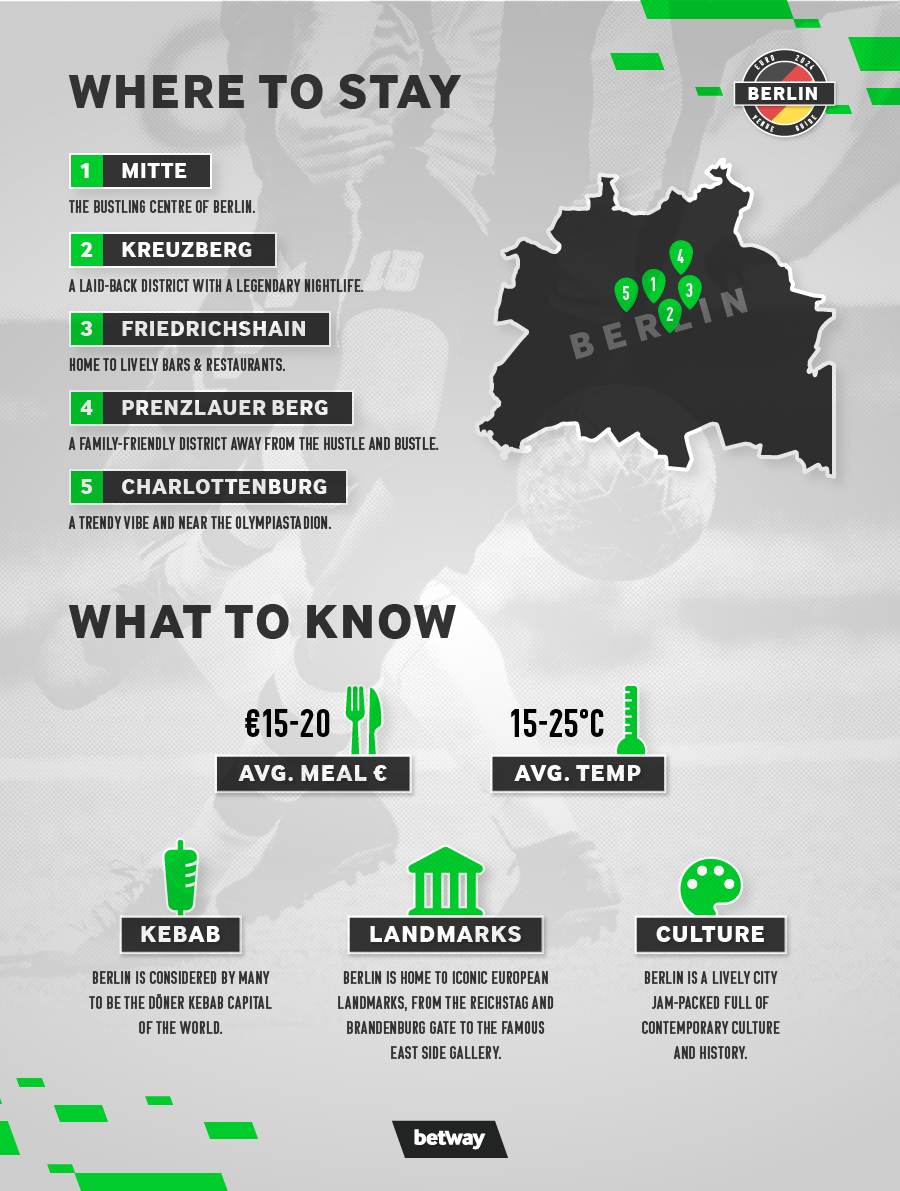
How to travel around Berlin
One of the great things about visiting Berlin is how easy it is to get around. Despite being Germany’s capital, it’s relatively walkable, with many of the main attractions situated within a short distance of each other, while everything else is just a train, bus, or taxi ride away.
As far as public transport goes, there are various modes to consider when travelling around Berlin:
· U-Bahn: The U-Bahn is an underground metro service that operates across Berlin and extends into some of the surrounding area. There are ten U-Bahn lines and 173 interconnected stations, meaning you’re very well connected to the city’s many neighbourhoods and landmarks.
· S-Bahn: The S-Bahn is another of Berlin’s rail systems, similar to the U-Bahn but operating above ground as well as underground. It connects Berlin across 16 lines and 168 stations.
· Tram: As if the S- and U-Bahns weren’t enough, Berlin also has a strong tram network with almost 800 stops throughout the city.
· Bus: Of course, if for any reason you can’t reach your destination by train or tram, you can always take the bus! The extensive bus network fills in the gaps and covers pretty much all areas of the city.
· Ferry: Yes, you’ve read that correctly… Berlin also has its very own ferry service that takes passengers to various destinations along the rivers and canals!
Berlin public transport tips and tricks
Berlin has a superbly efficient public transport system, helping you get around without fuss or difficulty – especially if you take note of the following tips and tricks:
· Validate your ticket: Once you’ve bought your ticket, you’ll also need to validate it before getting on the U-Bahn or S-Bahn. You can do this by using the red or yellow validation machine on the platforms. Be careful – despite paying for your ticket, if you don’t validate before travel, it won’t count, and you might have to pay a fine if caught by an inspector!
· Download the BVG app: One of our simplest Berlin travel tips, but sure to make getting around Berlin more straightforward, the BVG app is the go-to hub for buying public transport tickets, whether you’re traveling on the train, bus, or tram. Using the app saves you having to queue at the automated ticket machines.
· Group tickets: If you’re travelling in a small group (up to five people), you should be able to access a group ticket that covers you all for unlimited journeys within a 24-hour window. If you’re unsure how to choose this ticket, station staff will be happy to help.
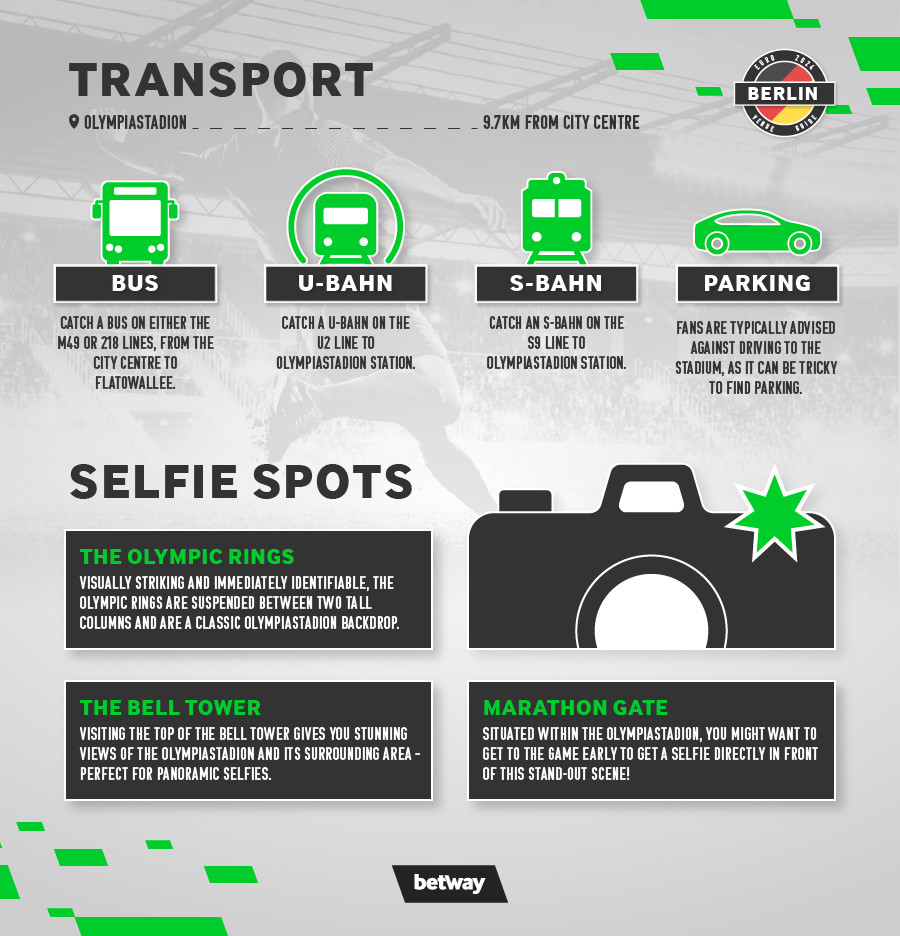
Where to eat in Berlin
Generally speaking, Berlin is a relatively affordable German city when it comes to dining out, especially when compared to other European capitals like London and Paris.
Of course, the cost of eating and drinking will vary heavily, depending on your chosen cuisine, type of restaurant, and location, but you can reasonably expect to spend between €15-20 for a standard main meal at a typical mid-range eatery. Speaking of which, some of the most popular mid-priced restaurants across a selection of popular cuisines include:
· German: Serving traditional German classics – think wurst and sauerkraut – Hackethals is a popular establishment among locals and tourists, earning an impressive 4.7-star rating on Google from around 1,200 reviews.
· Italian: Rated 4.7 stars on Google from 3,500+ reviews, Ristorante A MANO is one of Berlin’s most popular Italian restaurants, serving authentic pasta, delicious fish, and a range of grilled meats. Alternatively, Focaccino is another top-rated option, with the Italian known for its high-quality ingredients and exquisite pizzas.
· Greek: If you’re in the mood for Greek, then Taverna Athene might be right up your street. Offering a wide array of Grecian classics, enjoy everything from moussaka to gyros and traditional grilled favourites.
· Burgers: If burgers are your bag, then you can’t go wrong with Burgermeister, home of affordable favourites – including delicious vegetarian and vegan eats. With ten locations dotted across the city, you’re never far from a Burgermeister.
· Vietnamese: Finally, for Asian-infused meals that pack a punch, consider Co Chu – a popular Vietnamese restaurant specialising in pho, banh mi, and bun cha.
The best döner kebabs in Berlin
Berlin is considered by many to be the döner kebab capital of the world, but where abouts can you find the finest examples of this delicious takeaway treat? For the best kebab in Berlin, consider some of these top-rated establishments:
· Mustafa’s Gemüse Kebap: 4.3-rated on Google, from 17,900+ reviews
· Imren Grill: 4.3-rated on Google, from 1,500+ reviews
· Rosenthaler Grill & Schlemmerbuffet: 4.4-rated on Google, from 1,790+ reviews
· Rüyam Gemüse Kebab: 4.9-rated on Google, from 21,350+ reviews
· Nefis Gemüse Kebap: 4.9-rated on Google, from 1,600+ reviews
· Vöner: 4.3-rated on Google, from 1,900+ reviews (vegan)
With so many kebab-houses throughout the city (it’s what Berlin is famous for!), you’re also likely never more than a few minutes from a shop.
Berlin’s most picturesque photo spots
With history and culture around every bend, Berlin is jam-packed with picturesque photo-album-fillers, from lush parks and thought-provoking art to striking architecture. Some of the best places to visit in Berlin include:
· Brandenburg Gate: An iconic must-see, the Brandenburg gate is one of Berlin’s most recognisable landmarks. For an especially Insta-worthy snap, consider arriving around sunrise or sunset, and catch the extended shadows.
· Reichstag: Germany’s primary parliament building, the Reichstag is an architectural marvel, topped with a stunning glass dome. It’s one of the first places to consider if you’re wondering what to do in Berlin.
· Museum Island: A collection of five astonishing museums, Museum Island is a UNESCO World Heritage Site.
· East Side Gallery: The old East-West Berlin divide has been reimagined as a world-famous open-air art gallery, with beautiful murals from global artists. Among the most famous, you’ll find ‘Fraternal Kiss’
· Charlottenburg Palace: Whether you admire from afar or take in the lavish interior, this baroque palace is a fantastic photo-op waiting to happen.
· Viktoriapark: From waterfalls to vistas, this popular park has it all – completed by stunning views of the city. If you’re in need of ideas of things to do in Berlin between games, a trip to the park is an alternative to the busy fan zone.
The best day trips from Berlin
While you could feasibly spend a whole trip in Berlin, if you’re visiting for an extended period you might also want to explore some of the surrounding area. Some of the best day trips from Berlin by train include:
· Potsdam and Sanssouci Palace: Situated 36 kilometres south-west of Berlin, Potsdam is accessible by car or train (catch the direct S-Bahn to Potsdam Central). Often dubbed the Versailles of Germany, Sanssouci Palace is a stunning example of historical architecture, while Potsdam is widely considered to be one of the most beautiful cities in Europe.
· Spreewald: Roughly 89 kilometres south of Berlin, you’ll find the charming forest of Spreewald. Adored for its natural beauty, dense forest, and easy-breezy waterways, while away a day in nature.
· Harz Mountains: While this trip is on the longer side (239 kilometres west of Berlin), it’s well-worth the drive. You could even make an overnight stay of your trip. Harz boasts medieval German towns, nature in abundance, and unbeatably traditional German food. Treat it like a retreat!
· Szczecin: If you fancy a trip across the Polish border, Szczecin is worth a day trip from Berlin. Here, you’ll enjoy affordable food and interesting architecture. You’ll likely take the train, which takes about 2 hours 45 minutes.
Final things to know before visiting Berlin
From the weather to language and payment methods, it’s useful to have an idea of the type of city you’re visiting… so we’ve pulled together some essential things to know ahead of your visit to Berlin for the Euros!
Weather in Berlin
Perhaps the best time to visit Berlin for almost-guaranteed good weather, the city usually enjoys plenty of sunshine in June and July. Temperatures are likely to hover between 15-25°C, but heatwaves aren’t especially uncommon – so check the forecast before your trip.
Equally, while the chance of rain is slim, it can’t be guaranteed that you won’t experience any, so you might want to prepare accordingly!
Language
Unsurprisingly, the common language in Berlin is… German! However, many locals speak confidently in English, and the city will be well-equipped to communicate with football fans from all across Europe. If you do want to have a go at speaking the local language, though, some common German phrases include:
· Hallo (Hello)
· Bitte (Please)
· Tschüss (Bye!)
· Danke (Thanks)
· Entschuldigung (Excuse me)
· Sprechen sie Englisch? (Do you speak English?)
· Ich verstehe nicht (I don’t understand)
Payment
Before visiting Berlin, make sure to read up on local tipping culture, and bring along the right payment methods:
· Tipping: When eating out in Berlin (and Germany in general), you’re not expected to tip as standard – instead, gratuity is based on experience. In this case, a suggested tip of 10% of the total bill would be suitable.
· Cash or card: Most establishments will accept card payments, but it’s useful to carry around some cash for public transport, small shops and cafes, or street vendors.
Hospitals in Berlin
While you’d hope to not need to visit a hospital on your visit to Berlin for Euro 2024, it’s useful to know where to find the emergency room if required:
· Charité – Universitätsmedizin Berlin: There are several of these campuses across the city, all of which have an A&E department (translated as: Notaufnahme).
· Helios Klinikum Berlin-Buch: Located to the north-east of the city, this hospital has a dedicated A&E centre.
· Vivantes Klinikum Neukölln: Located to the south-east of the city, this hospital has a dedicated A&E centre.
· Alexianer St. Hedwig Hospital: Located in the city centre, this hospital has a dedicated A&E department.
Before you visit Berlin, you should also take a note of the medical emergency number (122), and the German word for hospital: Krankenhaus.
Explore the other Euro 2024 host cities
With our handy Berlin travel guide in tow, you should have no problem navigating the city during Euro 2024. And if you’re planning on city-hopping throughout the tournament, be sure to check out our other guides which explore the things to do and see in each of the other host locations:
· Cologne
· Dortmund
· Hamburg
· Leipzig
· Munich

